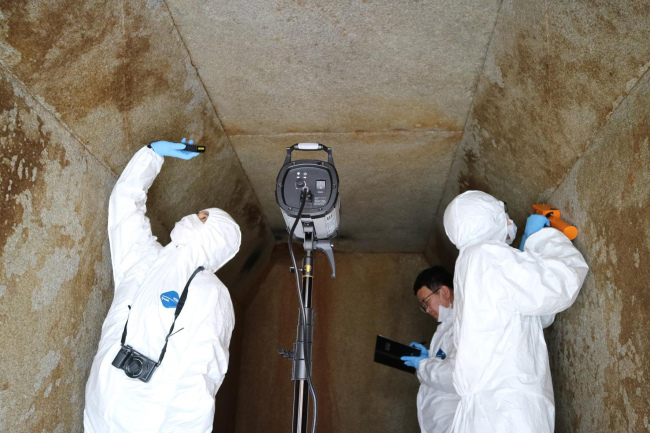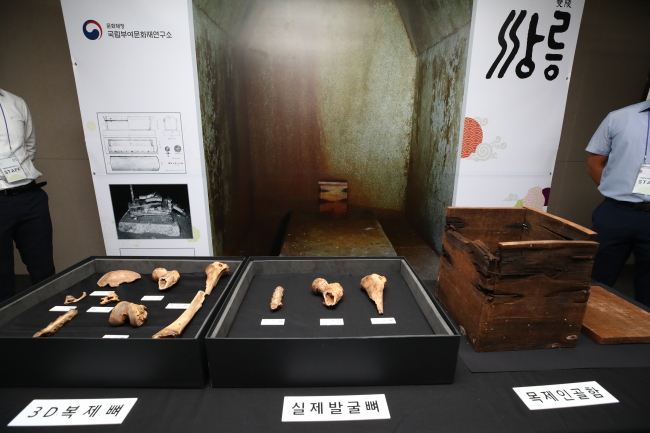King Mu of Baekje, the protagonist of a “Romeo and Juliet”-esque fable, may have been found, as researchers said Wednesday human remains uncovered in April are likely to be his.
Buyeo National Research Institute of Cultural Heritage held a press conference to reveal the results of their examination of remains found inside what is believed to be a royal tomb from Baekje Kingdom, which existed in the southwestern Korean Peninsula from 18 BC to AD 660. The tomb in Iksan, North Jeolla Province, was discovered by a governor-general of Korea during the Japanese colonial period, and had since been seen as a Baekje-era royal tomb.

Researchers examine the royal tomb in Iksan, North Jeolla Province, in this file photo. (Buyeo National Research Institute of Cultural Heritage)
But a lack of records restricted officials from pinpointing the exact occupant of the grave.
“The tomb is very large and its stone structure indicates a lot of effort went into building it. It has gold- and bronze-plated ornaments like other royal tombs in Gongju (in South Chungcheong Province), and there has been a theory that it was of the tomb of King Mu,” said Lee Sang-jun, chief of the Buyeo NRICH.
The stones used for the chambers are thought to have been mined from the town of Hamyeol, about 9 kilometers away, and Japanese umbrella pine tree wood, one of the best materials used during the time, was used to make the coffin.
A total of 102 bone pieces were exhumed in the April dig, an analysis of which found they were from a man presumably in his 60s or 70s. This was indicated by ossification in the thyroid cartilage, and further indications of a rigid spine, knee pain and other symptoms commonly found in older men.
Carbon dating of the tibula using the accelerator mass spectrometer dated it to 620-659.
The carbon dating corroborates records that show that King Mu died in 641, aged 61.

Bones (center) found in the royal tomb in Iksan, North Jeolla Province, are on display at a press conference in Seoul on Wednesday, next to 3D-printed versions of the bones (left) and the box in which they were found. (Yonhap)
It has been unclear whether the tomb was actually that of a king, given that the teeth recovered there had been thought to be that of a 20-something woman. Researchers, however, explained the previous analysis was based purely on the size of the teeth, and that analysis of the bones suggest otherwise.
“The only king to have died during that time was King Mu, although we will not say with absolute certainty that it is him. However, we believe that it would not have been easy for another nobleman to be buried in a tomb of this magnitude in Iksan at that time,” Lee said.
King Mu is one of the most well-known kings of Baekje, his key achievements being building the Mireuksa temple and a powerful military that pressured the neighboring Silla Kingdom.
But he is most famous as the hero of “Seodong-yo,” which tells the love story between a young Seodong and Silla Princess Seonhwa.
Legend has it that Baekje’s peasant boy Seodong -- Mu’s childhood name -- fell in love with Seonhwa and spread a rumor involving him and Seonhwa in Silla Kingdom. Infuriated by the rumors his daughter was in love with a man from a hostile country, the Silla king disowned the princess and banished her. Seodong married her and, using his wits, earned the trust of the Baekje king to eventually succeed him.
King Mu’s family background is actually unclear, as scholars are divided on his real father. But given hostile relations between Baekje and Silla during Mu’s time, and conflicting theories on who Seonhwa was or even if she existed, there have been suggestions the story may be one of pure imagination.
By Yoon Min-sik
(minsikyoon@heraldcorp.com)






![[From the Scene] Monks, Buddhists hail return of remains of Buddhas](http://res.heraldm.com/phpwas/restmb_idxmake.php?idx=645&simg=/content/image/2024/04/19/20240419050617_0.jpg&u=20240419175937)
